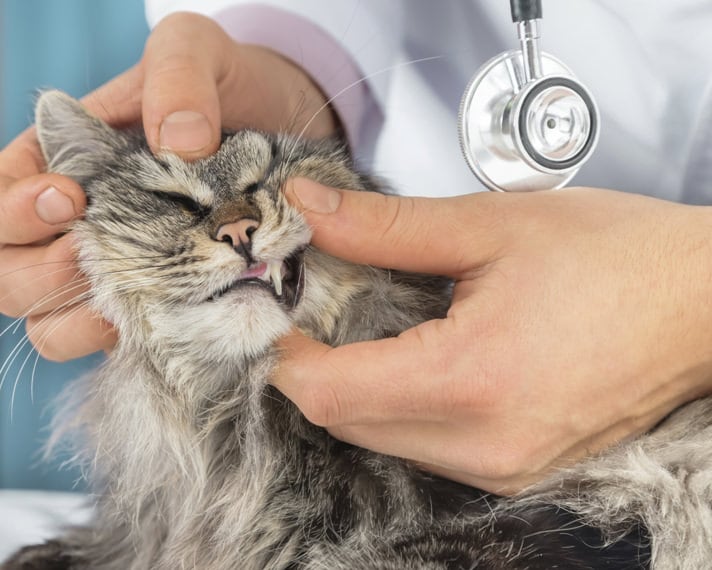Just like people, pets can develop a whole range of skin problems. Many common issues are easily resolved, but can be uncomfortable for your pet or progress into more serious problems if not identified and treated. Some dog breeds are just more prone to skin issues than others. If your pet is one of the following breeds, you may want to consult a veterinarian to determine if your dog has a breed-specific problem: Siberian Huskies, Alaskan Malamutes, and other fast-growing, large and hairless dogs—such as the Xoloitzuintli and Chinese Crested.
The good news: Most common skin issues are totally manageable or curable with the help of your veterinarian. If your pet is experiencing any of the typical skin problems below, it’s likely that there’s a very real solution for her discomfort.
The Problem: Dry or Flaky Skin
It may not sound like much of a problem at all—we all experience dry skin from time to time, right? But if this is a chronic issue for your pet, the itchiness and discomfort she feels might become seriously aggravating, causing her to scratch constantly and possibly rip out fur or damage the skin underneath. Dry skin conditions can also sometimes be a symptom of a much larger problem, like allergies, parasites or serious medical conditions such as hypothyroidism, so if your pet is experiencing consistently dry skin, it’s important to visit your veterinarian to determine the underlying cause.
What to Do About It: Dry skin that’s caused by everyday environmental irritants like harsh soaps or shampoos, cold weather or dry air, or lack of proper nutrition can be easily remedied by changing up your routine. If you’ve consulted your vet and know there isn’t a more serious root problem, try a limited ingredient diet dog food or cat food, purchase a humidifier to combat dry air in your home, or swap your current dog shampoo for a gentler, hypoallergenic shampoo. Just be cautious of changing too many things at once; try making one change at a time, then waiting a week or two to see if you notice a difference before mixing up anything else in your pet’s usual regimen. Your vet should be able to advise on the best approach.
The Problem: Allergic Dermatitis (Allergy-Induced Skin Rash)
Your cat or pup could be allergic to a whole host of common items around your home, like grooming products, food or environmental factors such as insects, dust or pollen. If your pet has a skin allergy, it could present as a rash or itchy, flaky or inflamed skin, but it’s best to visit your vet to be sure an allergy is the root cause.
What to Do About It: If your pet has serious allergies, your vet may decide that medication is necessary to keep them in check. Whether or not medicine is needed, though, there are several things you can do as a pet parent to keep irritants to a minimum and keep your pet’s allergies under control. Vacuum and mop floors frequently to remove allergens like dust, mites, plant pollen and loose hair from your home. Dust wood furniture, electronics, shelving and anything else in your home that may collect dust or other irritants, and wash linens, including curtains or drapes, regularly. If a cat or dog food is the cause of your pet’s allergy, you may try switching her to a limited ingredient diet, as there is no reliable test that can be done to diagnose a food intolerance.
The Problem: Pet Ringworm
Ringworm, though it sounds like a parasite, is actually a fungus. This infection can affect your pet’s hair, skin or nails, and is usually easy to diagnose. It presents as a round, red, raised ring around the infected area, along with areas of hair loss, brittle or broken nails, or scabby-looking lesions. While treatable, this fungus is contagious and can grow worse and multiply quickly if not addressed, so it’s crucial that you take your pet to the vet as soon as possible if you suspect ringworm.
What to Do About It: If your pet has ringworm, over-the-counter sprays can help provide relief against symptoms. But for treatment, it’s likely that your vet will prescribe a combination of topical and oral antifungal medications—the exact combination of medications will depend on the severity of the infection and your vet’s best judgment.
The Problem: Yeast Infection
Yeast infections in dogs and cats can appear as itchy, irritated or discolored skin, and will likely turn up around warm or damp places, such as the paws or ears, that give the yeast a chance to grow.
What to Do About It: If your pet has a yeast infection, your vet will likely prescribe a topical cream to treat it—but may also take further steps, like oral medications, if the infection is more serious.
The Problem: Mange
The root of this skin issue is tiny parasitic mites, and it usually appears as areas of patchy hair loss, especially around the face. There are two types of mange. The first is caused by mites that burrow underneath the surface of the skin, and the second is caused by mites that make themselves at home in your pet’s hair follicles. This second type is also called red mange (aka demodectic mange, in vet speak) and is the most common in dogs. Luckily, this infection is not contagious to other pets or humans and, as long as your pet’s immune system is healthy, shouldn’t cause any long-term or more serious problems.
What to Do About It: Mange occurs most often in puppies and younger dogs (pets under 18 months) with immature immune systems. If your vet diagnoses your pup with mange, she will likely treat it with a topical cream and, if more severe, possibly with medicated shampoos or soaps and oral medication to kill both lives mites and their eggs. If you suspect mange, you must take your dog to the veterinarian to receive proper treatment.
The Problem: Fleas
Fleas are another insect that can cause your pet serious discomfort. Though tiny, fleas leave behind evidence of their presence, such as itchy, red bites on your pet’s skin and visible droppings or eggs on her coat. Because fleas feed off of blood, if left untreated, an infestation can cause blood loss, anemia and other larger problems for your pet, so it’s essential to take her to the vet for treatment as soon as possible.
What to Do About It: As with allergy problems, parents of pets with fleas will want to do a very thorough cleaning job of the entire home to rid your environment of as many of these pests as possible. Your vet will also likely recommend topical and/or oral medications to kill existing fleas, and medicated flea collars to ensure they don’t return.
Share:













